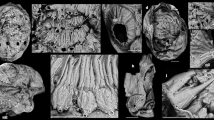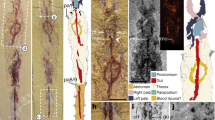Abstract
Ctenophores or comb jellies are tiny almost totally soft-bodied, bioluminescent planktonic organisms whose principal means of propulsion is the beating of eight ciliated bands which traverse their gelatinous exterior. Traditionally their distant ancestry has been thought to be linked to that of the Cnidaria, although recent detailed anatomical and ecological studies have been rallied to show that ctenophores have a history quite independent of cnidarians1. Until recently, ctenophores were unknown as fossils and quite naturally were not expected to be found. However, we recently reported a remarkable cydippid-like specimen, Paleoctenophora brasseli2, discovered in the Lower Devonian Hunsrück Slate of West Germany. This formation is now celebrated for its spectacularly well-preserved fossils, including the occasional pre-servation of tissue, organs and soft-parts3–5. Designated as Archeocydippida hunsrueckiana n. gen. n. sp., here we report an additional specimen discovered by X-rays. It reveals even more detail than our first specimen, including preservation of the delicate comb rows and possible gonads.
This is a preview of subscription content, access via your institution
Access options
Subscribe to this journal
Receive 51 print issues and online access
$199.00 per year
only $3.90 per issue
Buy this article
- Purchase on Springer Link
- Instant access to full article PDF
Prices may be subject to local taxes which are calculated during checkout
Similar content being viewed by others
References
1. Harbison, G. R, in The Origins and Relationships of Lower Invertebrates (eds Conway Morris, S., George, J. D., Gibson, R. & Platt, H. M.) 78–100 (Systematics Ass. Spec. Vol. 28, London, 1985). 2. Stanley, G. D. Jr & Sturmer, W. Nature 303, 518–520 (1983). 3. Sturmer, W. Science 170, 1300–1302 (1970). 4. Yochelson, E. L., Stunner, W. & Stanley, G. D. Jr Palaont. Z. 57, 39–68 (1983). 5. Sturmer, W. Nature 318, 53–55 (1985). 6. Moore, R. C. in Treatise on Invertebrate Paleontology Part O (ed. Moore, R. C.) O16–O21 (Geological Society of America and University of Kansas Press, Lawrence, Kansas, 1959). 7. Caster, K. E. & Brooks, H. K. Bull. Am. Pateont. 36, 157–199 (1956). 8. Hantzschel, W. in Treatise on Invertebrate Paleontology Part W (ed. Teichert, C.) W1–W269 (Geological Society of America and University of Kansas Press, Lawrence, Kansas, 1975). 9. Smith, A. B. Akheringa 6, 93–99 (1982). 10. Collins, D., Briggs, D, & Conway–Morris, S. Science 222, 163–167 (1983). 11. Simonetta, A. M. & Delle Cave, L. AttiSoc. Toscana Sci. Nat. Pisa Mem. Ser. 85,45–49 (1978). 12. Conway Morris, S. in The Origins and Relationships of Lower Invertebrates (eds Conway Morris, S., George, J. D., Gibson, R. & Platt, H. M.) 343–359 (Systematics Ass. Spec. Vol. 28, London, 1985). 13. Hyman, L. H. Invertebrates: Protozoa through Ctenophora (McGraw–HiH, New York, 1940). 14. Harbison, G. R., Madin, L. P. & Swanbert, N. R. Deep Sea Res. 25, 233–255 (1978). 15. Barrington, E. J. W. Invertebrate Structure and Function (Nelson, Sunbury–on–Thames, 1979). 16. Whittington, H. B. The Burgess Shale (Yale University Press, New Haven, 1985). 17. Harbison, G. R. & Miller, R. L. Mar. Biol. 90, 413–424 (1986).
Author information
Authors and Affiliations
Rights and permissions
About this article
Cite this article
Stanley, G., Stürmer, W. A new fossil ctenophore discovered by X-rays. Nature 328, 61–63 (1987). https://doi.org/10.1038/328061a0
Received:
Accepted:
Issue Date:
DOI: https://doi.org/10.1038/328061a0
This article is cited by
-
A late-surviving stem-ctenophore from the Late Devonian of Miguasha (Canada)
Scientific Reports (2021)
-
The fossil record and the early evolution of the Metazoa
Nature (1993)
Comments
By submitting a comment you agree to abide by our Terms and Community Guidelines. If you find something abusive or that does not comply with our terms or guidelines please flag it as inappropriate.



